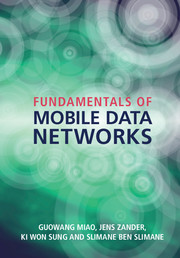Book contents
- Frontmatter
- Contents
- Preface
- Acronyms
- Notations
- 1 Introduction
- 2 Wireless network models
- 3 Medium access control
- 4 Scheduling
- 5 Principles of cellular systems
- 6 Transmitter power control
- 7 Interference management
- 8 Association and handover
- 9 Energy-efficient design
- 10 Long term evolution
- 11 Wireless infrastructure economics
- About the authors
- Index
- References
9 - Energy-efficient design
Published online by Cambridge University Press: 05 March 2016
- Frontmatter
- Contents
- Preface
- Acronyms
- Notations
- 1 Introduction
- 2 Wireless network models
- 3 Medium access control
- 4 Scheduling
- 5 Principles of cellular systems
- 6 Transmitter power control
- 7 Interference management
- 8 Association and handover
- 9 Energy-efficient design
- 10 Long term evolution
- 11 Wireless infrastructure economics
- About the authors
- Index
- References
Summary
Introduction
While semiconductor processing speed has been increasing exponentially, doubling almost every two years according to Moore's law, processor power consumption also continues to grow by 150% every two years [K. Lahiri et al., 2002]. By contrast, advances in battery technology have not kept pace, with capacity increasing at a modest rate of 10% every two years [K. Lahiri et al., 2002]. This leads to an increasingly large gap between power thirst and battery capacity. Information and communication technology (ICT) plays an important role in global greenhouse gas emissions since the amount of energy consumed by ICT is increasing dramatically to meet rapidly growing broadband mobile service requirements. For example, the power consumption for a macro base station can be 1400 watts and the corresponding energy costs can reach $3200 per annum with 11 tons of CO2 emissions. It has been shown that nowadays the total energy used by the infrastructure of cellular networks, wired networks and Internet takes up more than 2% of worldwide electrical energy consumption [GeSI, 2008]. The radio network itself adds up to 80% of an operator's entire energy consumption [EE Times, 2007]. In addition, this amount of energy is expected to increase rapidly in the coming years. Energy efficiency, therefore, is increasingly important for wireless mobile communications.
In this chapter we introduce some basic energy-efficient communication technologies. We start by studying node-level energy-efficient design, as improvements at the wireless node for energy-efficient radio transmission will translate into savings for the entire network. For an individual pair of wireless transceivers, the relation between power consumption, channel fading, path loss, modulation, coding, data rate and implementation factors are discussed thoroughly. To be specific, we will first analyze the energy consumption of different components of wireless transmitters. Then we will introduce the link energy efficiency metric that characterizes how efficiently energy is used in communication systems. Based on the energy efficiency metric, we will introduce how a communication pair can be designed in the most energy-efficient way. First, we will consider only radio transmission power consumption and show how the transmitter can be designed optimally to achieve the maximum energy efficiency. In practice, electronic circuits also consume a certain amount of operating power and this will significantly change the design of energy-efficient transmitters. We will study how this electronic circuit power consumption affects energy-efficient transmission.
- Type
- Chapter
- Information
- Fundamentals of Mobile Data Networks , pp. 227 - 257Publisher: Cambridge University PressPrint publication year: 2016



